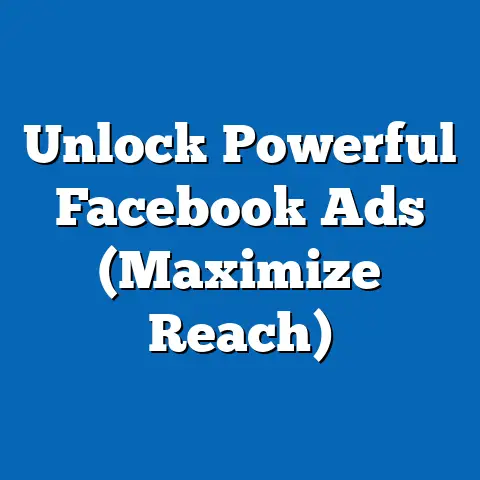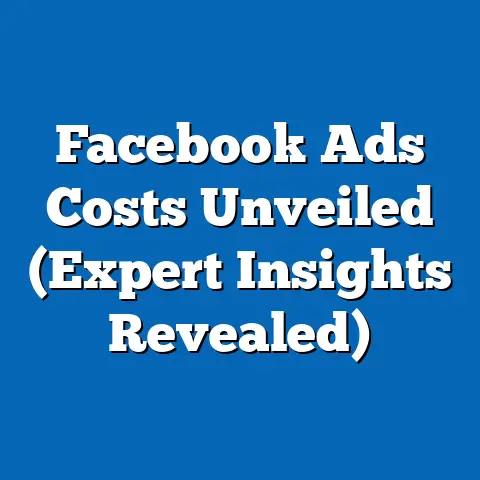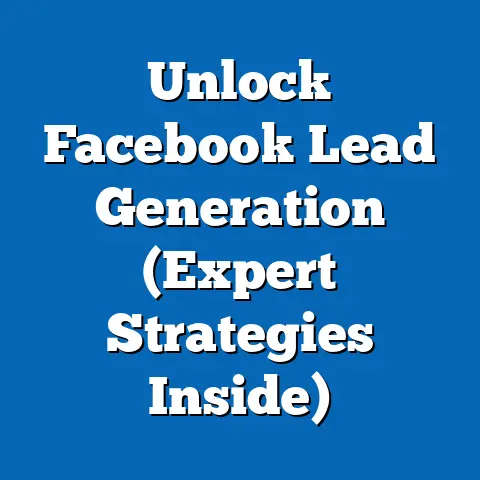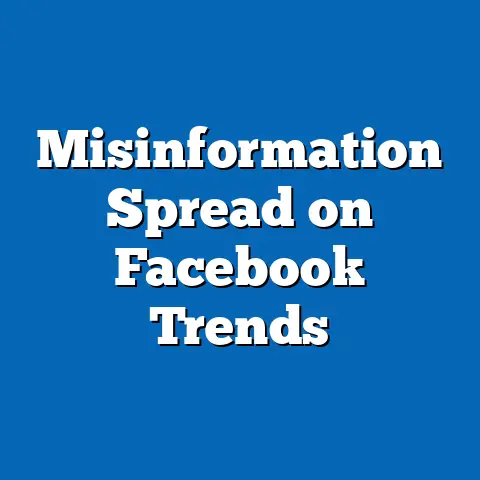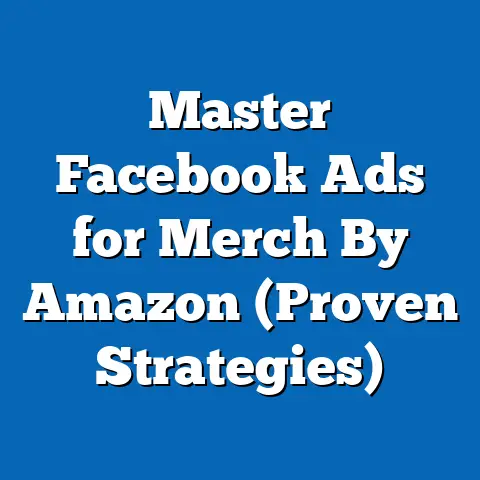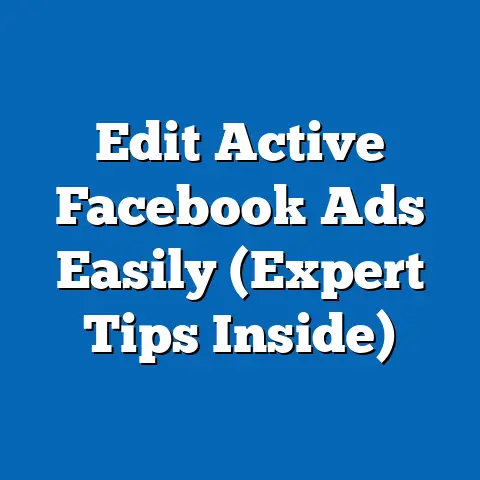Eliminate Facebook’s Repeated Ads (Effective Strategies)
Have you ever felt like you’re trapped in a Facebook ad loop, seeing the same advertisement over and over again? It’s frustrating, right? I know I have! It’s not just annoying; it can actually damage a brand’s image and effectiveness. As a digital marketing specialist, I’ve seen firsthand how repeated ads can lead to ad fatigue, making users tune out or even develop negative feelings toward a brand.
The problem is pervasive. Think about it – you’re scrolling through your feed, trying to catch up with friends and family, and bam! There it is again – that same ad for the fitness app you already downloaded (and maybe even deleted!). Or maybe it’s the furniture store that’s been haunting your dreams for weeks. It’s understandable that brands want to stay top-of-mind, but there’s a fine line between effective repetition and outright annoyance.
Recent statistics highlight the severity of this issue. According to a study by HubSpot, 63% of consumers find that ads are intrusive, particularly when they see the same ones repeatedly. This can lead to a significant decrease in engagement and a rise in negative brand associations. Moreover, a survey by MarketingSherpa revealed that 86% of people report ad fatigue when exposed to the same ads too frequently, which can diminish the ROI of your advertising campaigns.
The good news? There are effective strategies to combat this. It all starts with understanding how Facebook’s advertising budgets work and how they influence ad frequency. By mastering these budget options, advertisers can strategically allocate their resources to ensure ads reach the right audience without becoming repetitive.
Key Takeaways:
- Repeated ads can lead to ad fatigue and negative brand perception.
- Understanding Facebook’s advertising budgets is crucial for managing ad frequency.
- Audience overlap and saturation can contribute to ad repetition.
- Ad rotation and creative variations keep content fresh and engaging.
- Monitoring ad performance helps in adjusting strategies to reduce repeated ads.
1. Understanding Facebook Advertising Budgets
One of the foundational elements in managing ad frequency and preventing repetition is a solid understanding of Facebook’s advertising budgets. I remember when I first started running Facebook ads, I was completely overwhelmed by the different budget options. It felt like I was throwing money into a black hole! But over time, I learned that mastering these options is key to controlling how often your ads are shown and to whom.
1.1 Overview of Facebook Ad Budgeting
Facebook offers several types of budgets, each with its own implications for ad delivery and frequency. Let’s break them down:
- Daily Budgets: This is the average amount you’re willing to spend on an ad set each day. Facebook aims to spend this amount daily, though actual daily spend can fluctuate. For example, if you set a daily budget of $20, Facebook will try to spend around $20 each day, but it might spend a bit more or less depending on performance and competition.
- Lifetime Budgets: This is the total amount you’re willing to spend over the entire duration of your campaign. Facebook will distribute the budget over the scheduled time period. For instance, if you set a lifetime budget of $500 for a campaign running for 10 days, Facebook will aim to spend $50 per day on average.
- Campaign Budget Optimization (CBO): This feature allows Facebook to automatically distribute your budget across different ad sets within a campaign to get the best results. You set a budget at the campaign level, and Facebook optimizes the allocation based on each ad set’s performance.
How These Budgets Affect Ad Delivery and Frequency:
- Daily Budgets: With a daily budget, Facebook continuously tries to show your ad to as many people as possible within your target audience each day. This can lead to higher frequency if your audience is small, as the same people may see your ad multiple times.
- Lifetime Budgets: Lifetime budgets give Facebook more flexibility to adjust spending based on performance. If an ad is performing well, Facebook might spend more on it to maximize results, which could lead to higher frequency. Conversely, if an ad isn’t performing well, Facebook might reduce spending and frequency.
- CBO: CBO can help reduce ad repetition by allocating more budget to ad sets that are performing well and reaching a wider audience. However, if your campaign has a small target audience, even CBO might not prevent ad fatigue.
1.2 Setting Your Budget
Determining the right budget is crucial for balancing reach and frequency. It’s not just about how much you can afford to spend; it’s about how efficiently you can allocate your resources to achieve your business goals.
- Business Goals and Campaign Objectives: Start by defining what you want to achieve with your campaign. Are you trying to increase brand awareness, drive traffic to your website, or generate leads? Your objective will influence your budget. For example, a brand awareness campaign might require a higher budget to reach a wider audience, while a lead generation campaign might focus on a smaller, more targeted audience with a lower budget.
- Target Audience Size: The size of your target audience is a significant factor in determining your budget. A smaller audience will require a smaller budget, while a larger audience will require a larger budget to achieve meaningful reach. If your audience is too small, you risk ad saturation, where the same people see your ad too frequently.
- Industry Benchmarks: Research industry benchmarks to get an idea of how much other businesses in your niche are spending on Facebook ads. This can give you a starting point for setting your budget. For instance, according to Statista, the average cost-per-click (CPC) for Facebook ads in 2023 was around $0.97, while the average cost-per-thousand impressions (CPM) was around $12.07.
- Example: Let’s say you’re a local bakery looking to increase brand awareness in your city. Your target audience is residents within a 5-mile radius, which amounts to about 50,000 people. Based on industry benchmarks, you estimate a CPM of $10. To reach half of your audience (25,000 people) once, you would need a budget of $250. If you want to reach them multiple times over a month, you’ll need to increase your budget accordingly.
1.3 Budget Adjustments for Frequency Management
Adjusting your budget is a powerful way to influence ad frequency. By understanding how different budget settings affect ad delivery, you can fine-tune your campaigns to avoid ad fatigue.
- Increasing Budget: Increasing your budget can help you reach a wider audience, which can reduce the frequency of ads shown to the same people. However, it’s essential to monitor performance to ensure that the increased spend is generating incremental results.
- Decreasing Budget: Decreasing your budget can reduce ad frequency, but it can also limit your reach. This might be a good strategy if you notice that your ads are becoming repetitive and engagement is declining.
- Bid Caps: Bid caps allow you to control the maximum amount you’re willing to pay for a specific action, such as a click or an impression. By setting a bid cap, you can limit the number of impressions your ad receives, which can help prevent ad repetition.
- Example: Suppose you’re running a campaign with a daily budget of $50 and you notice that your ads are being shown to the same people multiple times per day. You can try increasing your budget to $75 to reach a wider audience or setting a bid cap to limit the number of impressions.
Takeaway: Understanding and strategically adjusting your Facebook ad budget is crucial for managing ad frequency and preventing ad fatigue. Experiment with different budget types, monitor performance, and adjust your strategy based on the results.
Next Steps:
- Review your current Facebook ad campaigns and identify the budget types you’re using.
- Analyze your target audience size and compare it to your budget to assess whether you’re at risk of ad saturation.
- Experiment with adjusting your budget and bid caps to see how it affects ad frequency and engagement.
2. Identifying Audience Overlap and Saturation
Another critical aspect of preventing repeated ads is understanding and managing your audience. I’ve learned that even the most creative and engaging ads can lose their effectiveness if shown too frequently to the same people. Audience overlap and saturation are significant contributors to this problem, so let’s explore how to identify and mitigate them.
2.1 Understanding Audience Targeting
Facebook’s audience targeting options are incredibly powerful, allowing you to reach specific demographics, interests, and behaviors. However, if not managed carefully, these options can also lead to audience overlap and ad repetition.
- Custom Audiences: These are audiences you create based on data you already have, such as email lists, website visitors, or app users. Custom audiences are highly targeted, but they can also be small, which increases the risk of ad saturation.
- Lookalike Audiences: These are audiences that Facebook creates based on your custom audiences. Facebook identifies users who share similar characteristics and behaviors with your existing customers, allowing you to expand your reach. While lookalike audiences can be effective, they can also overlap with other audiences if not refined properly.
- Interest-Based Targeting: This involves targeting users based on their interests, hobbies, and pages they’ve liked on Facebook. Interest-based targeting can be broad, which can lead to reaching irrelevant users, or too narrow, which can lead to ad repetition.
- Behavioral Targeting: This allows you to target users based on their online behaviors, such as purchase history, device usage, and travel habits. Behavioral targeting can be precise, but it’s essential to ensure that your audience is large enough to avoid ad saturation.
Importance of Audience Segmentation:
Audience segmentation is the process of dividing your target audience into smaller, more specific groups based on shared characteristics. By segmenting your audience, you can tailor your ads to each group’s specific needs and interests, which can increase engagement and reduce the likelihood of ad repetition.
- Example: Suppose you’re selling fitness apparel. You can segment your audience based on their fitness interests, such as yoga, running, or weightlifting. You can then create ads that specifically target each group, showcasing apparel that is relevant to their activities.
2.2 Analyzing Audience Overlap
Audience overlap occurs when the same users are included in multiple target audiences. This can lead to ad saturation and decreased engagement. Facebook Ads Manager provides tools to identify audience overlap and take steps to minimize it.
- Using Facebook Ads Manager: Facebook Ads Manager has a feature that allows you to compare different audiences and see how much overlap exists between them. To access this feature, go to the “Audiences” section in Ads Manager, select the audiences you want to compare, and click on “Show Audience Overlap.”
- Interpreting the Results: The audience overlap tool will show you a percentage of users who are included in both audiences. If the overlap is high, it means that the same people are seeing your ads from multiple campaigns, which can lead to ad fatigue.
- Strategies for Minimizing Audience Overlap:
- Refining Audience Parameters: Adjust the parameters of your audiences to make them more distinct. For example, you can exclude certain demographics or interests from one audience to avoid overlap with another.
- Excluding Certain Demographics: Use the exclusion feature in Ads Manager to prevent certain demographics from seeing your ads. This can be particularly useful if you’re targeting multiple audiences with similar characteristics.
- Combining Audiences: If two audiences have a high degree of overlap, consider combining them into a single audience to simplify your targeting and reduce ad repetition.
- Refining Audience Parameters: Adjust the parameters of your audiences to make them more distinct. For example, you can exclude certain demographics or interests from one audience to avoid overlap with another.
- Excluding Certain Demographics: Use the exclusion feature in Ads Manager to prevent certain demographics from seeing your ads. This can be particularly useful if you’re targeting multiple audiences with similar characteristics.
- Combining Audiences: If two audiences have a high degree of overlap, consider combining them into a single audience to simplify your targeting and reduce ad repetition.
2.3 The Role of Audience Saturation in Ad Frequency
Audience saturation occurs when you’ve shown your ad to a significant portion of your target audience multiple times. This can lead to ad fatigue, decreased engagement, and negative brand associations.
- Impact on Ad Effectiveness: When an audience becomes saturated, the effectiveness of your ads decreases. Users start to tune out your ads, and they may even develop negative feelings toward your brand.
- Ways to Refresh Audiences:
- Periodically Update Custom Audiences: Regularly update your custom audiences with new data to ensure that you’re reaching the most relevant users. For example, you can add new email subscribers to your email list or update your website visitor list with recent visitors.
- Expand Lookalike Audiences: Periodically expand your lookalike audiences to reach new users who are similar to your existing customers.
- Try New Interest-Based Targeting: Experiment with new interest-based targeting options to reach users who might be interested in your products or services but haven’t been exposed to your ads yet.
- Periodically Update Custom Audiences: Regularly update your custom audiences with new data to ensure that you’re reaching the most relevant users. For example, you can add new email subscribers to your email list or update your website visitor list with recent visitors.
- Expand Lookalike Audiences: Periodically expand your lookalike audiences to reach new users who are similar to your existing customers.
- Try New Interest-Based Targeting: Experiment with new interest-based targeting options to reach users who might be interested in your products or services but haven’t been exposed to your ads yet.
Takeaway: Identifying and managing audience overlap and saturation is crucial for preventing ad repetition and maintaining engagement. Use Facebook Ads Manager to analyze audience overlap, refine your audience parameters, and refresh your audiences periodically.
Next Steps:
- Analyze the audience overlap between your current Facebook ad campaigns.
- Refine your audience parameters to minimize overlap and reduce ad repetition.
- Develop a plan for refreshing your audiences periodically to maintain engagement.
3. Ad Rotation and Creative Variations
Let’s talk about one of the most effective ways to combat ad fatigue: ad rotation and creative variations. I’ve found that consistently rotating ad creatives is like giving your audience a breath of fresh air, keeping them engaged and preventing them from tuning out your messages.
3.1 Importance of Ad Creative Variability
Ad fatigue is a significant challenge for advertisers. When users see the same ad creative repeatedly, they become less likely to engage with it. This can lead to decreased click-through rates, lower conversion rates, and a decline in overall ad performance.
- How Ad Fatigue Occurs: Ad fatigue occurs when users become overexposed to an ad creative. They start to recognize the ad and tune it out, even if it’s relevant to their interests.
- Benefits of Rotating Ad Creatives:
- Keeps Content Fresh: Rotating ad creatives keeps your content fresh and engaging, preventing users from becoming bored or annoyed.
- Increases Engagement: New and interesting ad creatives are more likely to capture users’ attention and encourage them to engage with your ads.
- Improves Performance: By rotating ad creatives, you can continuously optimize your campaigns for performance, identifying which creatives resonate best with your audience.
- Keeps Content Fresh: Rotating ad creatives keeps your content fresh and engaging, preventing users from becoming bored or annoyed.
- Increases Engagement: New and interesting ad creatives are more likely to capture users’ attention and encourage them to engage with your ads.
- Improves Performance: By rotating ad creatives, you can continuously optimize your campaigns for performance, identifying which creatives resonate best with your audience.
3.2 Implementing Ad Rotation Strategies
Implementing ad rotation strategies is essential for keeping your ad content fresh and engaging. Here are some practical strategies to consider:
- A/B Testing Different Creatives: A/B testing involves creating multiple versions of your ad creative and testing them against each other to see which performs best. This allows you to identify which visuals, headlines, and calls to action resonate most with your audience.
- Using Dynamic Ad Features: Facebook’s dynamic ad features allow you to automatically generate variations of your ads based on different elements, such as product images, headlines, and descriptions. This can help you create a wide range of ad creatives without manually creating each one.
- Maintaining Consistent Messaging: While it’s essential to vary your visuals and calls to action, it’s also crucial to maintain consistent messaging across your ad creatives. This ensures that your brand message remains clear and consistent, even as you rotate your ads.
3.3 Utilizing Facebook’s Dynamic Creative Feature
Facebook’s dynamic creative feature is a powerful tool for reducing ad repetition while optimizing for performance. It allows you to upload multiple versions of your ad elements, such as images, videos, headlines, and descriptions, and Facebook automatically generates variations of your ads based on these elements.
- How Dynamic Creative Works: You upload multiple versions of your ad elements, and Facebook combines them in different ways to create a variety of ad creatives. Facebook then tests these variations to see which performs best and automatically optimizes your ads based on the results.
- Benefits of Using Dynamic Creative:
- Reduces Ad Repetition: By automatically generating variations of your ads, dynamic creative helps reduce ad repetition and prevents ad fatigue.
- Optimizes for Performance: Facebook’s algorithm continuously tests different ad variations to see which performs best, ensuring that your ads are always optimized for engagement and conversions.
- Saves Time and Effort: Dynamic creative automates the process of creating and testing ad creatives, saving you time and effort.
- Reduces Ad Repetition: By automatically generating variations of your ads, dynamic creative helps reduce ad repetition and prevents ad fatigue.
- Optimizes for Performance: Facebook’s algorithm continuously tests different ad variations to see which performs best, ensuring that your ads are always optimized for engagement and conversions.
- Saves Time and Effort: Dynamic creative automates the process of creating and testing ad creatives, saving you time and effort.
Takeaway: Ad rotation and creative variations are essential for preventing ad fatigue and maintaining engagement. Implement ad rotation strategies, A/B test different creatives, and utilize Facebook’s dynamic creative feature to keep your content fresh and optimized for performance.
Next Steps:
- Develop a plan for rotating your ad creatives regularly.
- Create multiple versions of your ad creatives and A/B test them against each other.
- Experiment with Facebook’s dynamic creative feature to generate variations of your ads automatically.
4. Monitoring and Analyzing Ad Performance
To truly eliminate repeated ads, you can’t just set and forget. It’s crucial to monitor and analyze your ad performance continuously. I’ve learned that the data tells a story – a story about what’s working, what’s not, and where you need to make adjustments.
4.1 Setting Up Performance Metrics
Setting up the right performance metrics is essential for monitoring your ad performance and identifying potential issues, such as ad repetition and ad fatigue.
- Key Performance Indicators (KPIs):
- Reach: The number of unique users who saw your ad.
- Frequency: The average number of times each user saw your ad.
- Engagement Rate: The percentage of users who interacted with your ad, such as liking, commenting, or sharing.
- Click-Through Rate (CTR): The percentage of users who clicked on your ad.
- Conversion Rate: The percentage of users who completed a desired action, such as making a purchase or filling out a form.
- Setting Up Dashboards: Create dashboards in Facebook Ads Manager or use third-party analytics tools to track your KPIs over time. This allows you to quickly identify trends and patterns in your ad performance.
- Example: Set up a dashboard that tracks reach, frequency, engagement rate, CTR, and conversion rate for each of your ad campaigns. Monitor these metrics daily or weekly to identify potential issues.
- Reach: The number of unique users who saw your ad.
- Frequency: The average number of times each user saw your ad.
- Engagement Rate: The percentage of users who interacted with your ad, such as liking, commenting, or sharing.
- Click-Through Rate (CTR): The percentage of users who clicked on your ad.
- Conversion Rate: The percentage of users who completed a desired action, such as making a purchase or filling out a form.
4.2 Analyzing Frequency and Engagement Data
Analyzing frequency and engagement data is crucial for understanding how your ads are performing and identifying potential ad fatigue.
- Interpreting Frequency Metrics: A high frequency means that your ads are being shown to the same people multiple times, which can lead to ad fatigue. A low frequency means that your ads aren’t being shown enough to make an impact.
- Correlation with Engagement: Monitor the correlation between frequency and engagement. If you notice that engagement is declining as frequency increases, it’s a sign that your ads are becoming repetitive and you need to make adjustments.
- User Feedback and Comments: Pay attention to user feedback and comments on your ads. Negative comments about seeing the same ad too often are a clear sign that you need to reduce ad frequency.
4.3 Adjusting Strategies Based on Performance Insights
Based on your performance insights, you may need to adjust your ad strategies to reduce repeated ads.
- Pivoting Ad Strategies:
- Adjusting Budget: If you’re seeing high frequency and declining engagement, try reducing your budget to limit the number of impressions your ad receives.
- Refining Audience Targeting: Refine your audience targeting to reach a wider audience and reduce the likelihood of ad repetition.
- Rotating Ad Creatives: Rotate your ad creatives more frequently to keep your content fresh and engaging.
- Continuous Testing and Iteration: Continuously test and iterate your ad strategies based on your performance insights. This allows you to identify what’s working and what’s not, and make adjustments accordingly.
- Adjusting Budget: If you’re seeing high frequency and declining engagement, try reducing your budget to limit the number of impressions your ad receives.
- Refining Audience Targeting: Refine your audience targeting to reach a wider audience and reduce the likelihood of ad repetition.
- Rotating Ad Creatives: Rotate your ad creatives more frequently to keep your content fresh and engaging.
Takeaway: Monitoring and analyzing ad performance is crucial for identifying and addressing issues such as ad repetition and ad fatigue. Set up performance metrics, analyze frequency and engagement data, and adjust your strategies based on your insights.
Next Steps:
- Set up performance metrics for your Facebook ad campaigns.
- Analyze frequency and engagement data to identify potential ad fatigue.
- Adjust your ad strategies based on your performance insights.
5. Leveraging Retargeting and Lookalike Audiences
Now, let’s explore how to leverage retargeting and lookalike audiences to reach new users without overwhelming them with repeated ads. I’ve found that these strategies, when implemented thoughtfully, can significantly enhance your advertising efforts.
5.1 Understanding Retargeting
Retargeting is a powerful advertising technique that allows you to reach users who have previously interacted with your brand. This can include users who have visited your website, viewed your products, or engaged with your content.
- Concept of Retargeting: Retargeting works by placing a pixel on your website or app, which tracks users who visit your site or use your app. You can then use this data to create retargeting audiences and show ads specifically to these users.
- Benefits of Retargeting:
- Higher Engagement: Retargeting ads are more likely to be relevant to users who have already shown an interest in your brand, which can lead to higher engagement rates.
- Improved Conversion Rates: Retargeting can help you convert users who were previously on the fence, reminding them of your products or services and encouraging them to take action.
- Retargeting vs. Broad Audience Targeting: Retargeting is more targeted than broad audience targeting, as it focuses on users who have already shown an interest in your brand. This can lead to higher engagement and conversion rates, but it also means that your audience is smaller.
- Higher Engagement: Retargeting ads are more likely to be relevant to users who have already shown an interest in your brand, which can lead to higher engagement rates.
- Improved Conversion Rates: Retargeting can help you convert users who were previously on the fence, reminding them of your products or services and encouraging them to take action.
5.2 Creating Effective Retargeting Campaigns
Creating effective retargeting campaigns requires careful planning and execution. Here are some tips to consider:
- Frequency Capping: Frequency capping allows you to limit the number of times a user sees your retargeting ads. This helps prevent ad fatigue and ensures that your ads don’t become annoying.
- Tailored Messaging: Tailor your retargeting ads to the specific actions that users have taken. For example, if a user viewed a specific product on your website, show them an ad for that product.
- Dynamic Product Ads: Dynamic product ads allow you to automatically show users ads for the products they viewed on your website. This is a highly effective way to retarget users and encourage them to make a purchase.
5.3 Using Lookalike Audiences to Expand Reach
Lookalike audiences are audiences that Facebook creates based on your existing custom audiences. Facebook identifies users who share similar characteristics and behaviors with your existing customers, allowing you to expand your reach without repeating ads to the same audience.
- How Lookalike Audiences Work: You upload a custom audience to Facebook, and Facebook analyzes the characteristics and behaviors of the users in that audience. Facebook then creates a new audience of users who share similar characteristics and behaviors.
- Best Practices for Creating Lookalike Audiences:
- Use High-Quality Custom Audiences: The quality of your lookalike audience depends on the quality of your custom audience. Use high-quality custom audiences that are based on users who have taken valuable actions, such as making a purchase or filling out a form.
- Refine Lookalike Audience Parameters: Refine the parameters of your lookalike audience to ensure that you’re reaching the most relevant users. For example, you can specify the location, age, and interests of your lookalike audience.
- Use High-Quality Custom Audiences: The quality of your lookalike audience depends on the quality of your custom audience. Use high-quality custom audiences that are based on users who have taken valuable actions, such as making a purchase or filling out a form.
- Refine Lookalike Audience Parameters: Refine the parameters of your lookalike audience to ensure that you’re reaching the most relevant users. For example, you can specify the location, age, and interests of your lookalike audience.
Takeaway: Leveraging retargeting and lookalike audiences can help you reach new users without overwhelming them with repeated ads. Implement frequency capping, tailor your messaging, and use high-quality custom audiences to create effective retargeting and lookalike campaigns.
Next Steps:
- Implement frequency capping in your retargeting campaigns.
- Tailor your retargeting ads to the specific actions that users have taken.
- Create lookalike audiences based on your existing custom audiences.
Conclusion
Eliminating repeated ads on Facebook is not just about improving user experience; it’s about optimizing your advertising strategy for maximum impact. I’ve shared a wealth of strategies in this guide, from understanding and adjusting your advertising budgets to identifying audience overlap, implementing ad rotation, monitoring performance, and leveraging retargeting and lookalike audiences.
By mastering these strategies, you can ensure that your ads reach the right audience without becoming repetitive, which can lead to ad fatigue and negative brand associations. Remember, the key is to be strategic, data-driven, and adaptable. Continuously monitor your ad performance, test new approaches, and adjust your strategies based on the results.
Key Strategies to Remember:
- Effective Budgeting: Master Facebook’s budget options and adjust your budget based on your business goals and target audience size.
- Audience Management: Identify and minimize audience overlap, and refresh your audiences periodically to maintain engagement.
- Creative Variability: Implement ad rotation strategies and utilize Facebook’s dynamic creative feature to keep your content fresh.
- Performance Monitoring: Set up performance metrics, analyze frequency and engagement data, and adjust your strategies based on your insights.
- Retargeting Strategies: Implement frequency capping, tailor your messaging, and use high-quality custom audiences to create effective retargeting and lookalike campaigns.
Now, it’s time to take action! Review your current Facebook advertising efforts, identify areas for improvement, and implement the strategies outlined in this guide. By taking a proactive approach to eliminating repeated ads, you can enhance your Facebook advertising efforts, improve overall user experience, and drive better results for your business.
Start today and transform your Facebook advertising from an annoyance to an asset. Your audience will thank you for it!

